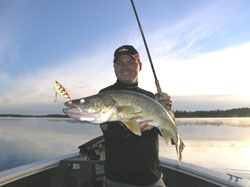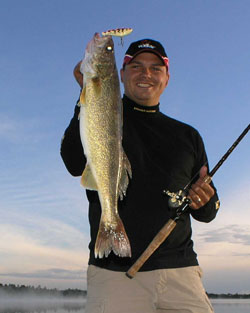 Even before the ice disappears, some anglers have already caught fat spring walleye. Throughout the Midwest states and border-waters with open spring walleye seasons, anglers flock to rivers and flowages to get a jump on the fishing—and for good reason. The early season is the perfect time to say good-bye to the winter blues and get the kinks out of your casting arm.
Even before the ice disappears, some anglers have already caught fat spring walleye. Throughout the Midwest states and border-waters with open spring walleye seasons, anglers flock to rivers and flowages to get a jump on the fishing—and for good reason. The early season is the perfect time to say good-bye to the winter blues and get the kinks out of your casting arm.
While some anglers pull their boats out of storage to drift along frigid waterways, others “hoof it” and stand upon the banks, casting into the current. Though a boat may provide flexibility for location, shore fishing requires less time and is easily accomplished during the fleeting hours after a family dinner or over the short span of a lunch hour.
Walleye enter these rivers and tributaries for one simple reason; spawning. Male walleye first enter the area and feed rather aggressively. Shortly thereafter, female walleye appear and with the help of one or more male fish, drop 175,000 eggs on average into the cracks of crevices of the rocky terrain. After one to two weeks, the fry hatch, initially feeding on the remains of the egg sac, gradually progressing to larger meals as the fish matures in size.
Yet before walleye actually lay their eggs, a period of heightened feeding activity takes place. Preparing for the strenuous process of reproduction, walleye devour as much sustenance as possible, which primarily consists of native river minnows.
Anglers looking to capitalize on the spring walleye run understand the productive nature of a carefully selected live minnow, yet in many cases, a minnow’s artificial counterpart, a crankbait, is even better.
 Crankbaits are deadly in areas with moving water for several reasons. First, the current can make the crankbait wobble and vibrate with little effort from the angler. Second, a crankbait more suitably covers water as each cast is retrieved faster and over greater expanses compared to conventional minnow rigs. And third, there is no need to rebait the hook. That means you won’t haul a minnow bucket along for the trip either.
Crankbaits are deadly in areas with moving water for several reasons. First, the current can make the crankbait wobble and vibrate with little effort from the angler. Second, a crankbait more suitably covers water as each cast is retrieved faster and over greater expanses compared to conventional minnow rigs. And third, there is no need to rebait the hook. That means you won’t haul a minnow bucket along for the trip either.
While perusing the tackle aisles for the perfect crankbait, consider the natural forage already present in the river or tributary where you’ll fish. Similar colors, shapes and sizes should be your first choice. Then think about the water clarity in choosing a few other lures. Bright, fluorescent colors will stand out against muddy or stained water, giving walleye an easier target despite their not-so-natural appearance.
Both lipped and lipless crankbaits are easily cast and retrieved for spring walleye but diving depth is important. Many of the most productive spring walleye fishing areas are approximately 3-8 feet deep and since walleye are primarily bottom relative, your crankbait should travel in close proximity to the bottom. It’s acceptable and in many cases desirable to make bottom contact with your crankbait. The Salmo Perch, Bullhead and Minnow crankbaits are good choices for spring walleye, while the Salmo Zipper, a lipless crankbait popular with bass anglers, has a unique action that spring walleye gobble up too. Used with a braided line like Spiderwire or Fireline, the crankbaits dive to their deepest potential, the angler has the highest level of sensitivity due to the line’s zero stretch properties and the durability will haul in even the biggest walleye (or a big stick if accidentally hooked).
As you continually cast and retrieve these premium crankbaits, periodically check the point of each treble hook and your fishing line. Contact with rocks, wood and other unidentified items can damage the point of your hook, your knot and your line, even with high-quality components. A few strokes with a sharpening stone and a quick re-tie will get you back to catching even more spring walleye.










